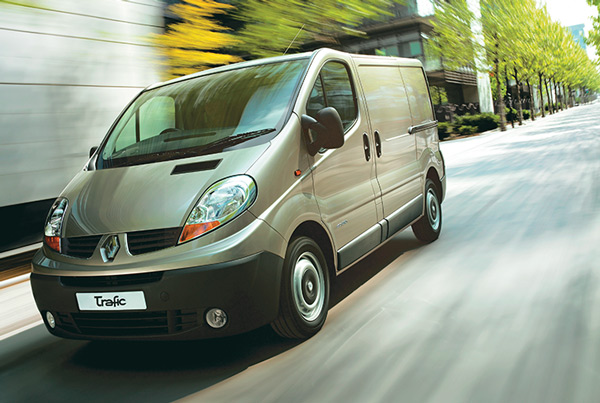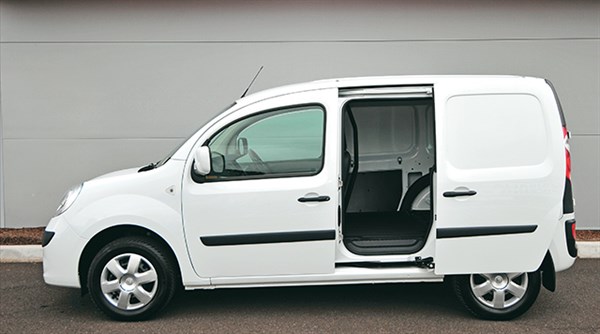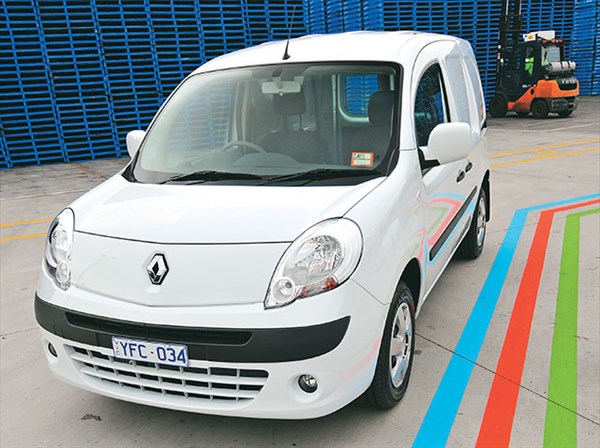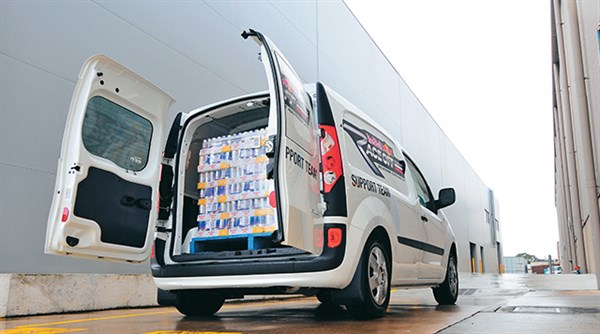Renault’s light-commercial vehicle (LCV) range has been updated versions of the Renault Trafic and Renault Kangoo models. Rob McKay and Greg Bush put the LCVs through their paces — will they do a resto job on the brand’s reputation?
Any offer to test drive Renault’s updated light-commercial vehicle (LCV) range is much too appetising to pass up, mainly because it’s been a rare occurrence in recent years. One could almost label the French manufacturer as publicity-shy, most notably in the commercial vehicle department.
However, the appointments of Managing Director Justin Hocevar and National Fleet Manager Jim Boyd look to be first step in revitalising the French manufacturer’s image in Australia.
Both new versions of the Trafic and its smaller relative the Kangoo are, according to Renault, entering ‘phase three’. Hocevar, who joined the company in September 2010, is keen for the mid-sized Trafic to take on the likes of the Mercedes-Benz Vito, the VW Transporter and the Hyundai iLoad.
ATN road-tested three vehicles – including two variants of the Kangoo – firstly for a spin through Melbourne’s CBD before taking a run down to Frankston, Seaford and up to Sandown Park.
Engine
The Trafic’s engine is a Euro 4, 2-litre, four-cylinder, 16-valve diesel that produces 85kW (114hp) at 3,500rpm and 290Nm at 1,600rpm.
There are two versions of the smallest member of the Renault light-commercial family: a manual 1.5-litre common-rail diesel, and the 1.6-litre petrol automatic.
Power-wise, the 1.5-litre 63kW (84hp) diesel pushes out 200Nm at 1,900rpm, while for the 78kW (105hp) petrol it’s 148Nm at 3,750rpm.
Transmission
Both standard- and long-wheelbase Trafic models use the same engine, mated to a choice of six-speed manual transmission or six-speed, clutch-pedal-free automated Quickshift ‘box.
However, the Renault Kangoo petrol model ships with a 4-speed auto transmission and its diesel counterpart has a 5-speed manual.
Cab and Controls
Renault Trafic
If there is to be the slightest of quibbles here, it might be that the headrest for the middle seat obscures the rear windows. But then, if that seat is occupied and the load space is carrying the five cubic-metres (or 6cu-m, depending on the option) it can fit inside, why worry?
Vision forward is exemplary, with large areas of glass ahead and on either side and without the slight ‘goldfish bowl’ feeling many modern smaller vans can sometimes engender.

The central console, with its off-floor mounted gear-lever, is more semi-circle than oval, meaning the driver’s left foot is forced to sit at 45 degrees unless it is brought back near the seat and beneath the knee.
For relatively short runs, that will be forgotten as soon as the steering wheel is vacated, however, for those who’ll be spending most of their time driving it, it may become like a pebble – small, but sharp enough – in your shoe.
Perhaps the chances of it becoming an issue are enhanced by the additions on the previous model that could put such otherwise minor things into sharper relief.
The phase-three vehicle gains attributes in common with the most modern cars, such as a steering wheel with integrated cruise-control buttons and a new four-speaker radio that features CD/MP3 functionality as well as an RCA auxiliary jack and Bluetooth connectivity for wireless audio streaming and phone calls.
Heading the options list is a Tom Tom satellite navigation system that features a handy remote control unit that clips into the storage cubby when not in use.
Also in the long list of options are climate control (with a further option of additional heating), automatic lights and wipers, a full steel bulkhead, a glazed bulkhead, driver rear cabin protection mesh, glazed tailgate, right-hand sliding door with opening window, front fog lamps, body coloured bumper, 16-inch alloy wheels and rear parking sensors.
Renault says that “safety is a top priority”, so all Trafic models have ABS brakes with electronic brake-force distribution, as well as height-adjustable seatbelts with pre-tensioners and load limiters.
However, electronic stability control is optionally available on manual transmission models at present.
Access to the cargo areas is drama-free: the back barn doors can be unhitched to open almost to 180 degrees to reveal an unimpeded approach to the cargo space.
The sliding side door opened smoothly and as wide as needed.
Sure to attract risk-averse operators, the Trafic comes with a 12-month or 15,000km service interval as well as a three-year, 150,000km warranty, along with 24-hour roadside assistance for three years.
Renault Kangoo
Niceties inside included adjustable steering wheel, cloth-covered seating, and a glovebox large enough to hold two laptop computers.
Like the Trafic, the Kangoo comes with Bluetooth connectivity and cruise control; the latter coming in handy while crusing down Eastlink.
As with the Trafic, both Kangoos are Euro 4-compliant and are an economical option for those in the light-delivery sector. Again, both carry a three-year, 150,000km warranty.
Performance
Renault Trafic
Firstly, a plea to all commercial vehicle manufacturers: though we value the effort you go to get us in a new one, and though it can be an extra organisational hassle, please place a cargo burden in the back for test drives if at all possible.
While vans and trucks make many trips without a load, that is not the business end of transport, nor one prospective buyers really need to know about. But enough of that – let’s go driving.
To be sure, the updated Renault Trafic is not hugely changed from its predecessor but the changes that have been made put it in the technology space it needs to be in.
And while there might be regulatory moves afoot to curtail in-vehicle communications, the fact is that without them, freight transport is destined for confusion and inefficiency.
This first notable impression of the phase-three Trafic came while backing out of Melbourne’s Mantra Southbank Hotel car park and onto busy City Road: the big, slightly convex side mirrors and inside rear-view mirror give the driver a great sight of what lies behind.
The split lower quarter of the outside mirrors also make very plain where the kerbs and other impediments to the wheels are likely to be. Close enough on either side for an intimate view, they come into their own again when the van is amongst its namesake on the road.
The cloth-covered driver’s seat gives requisite support and, after 60km of mostly freeway driving down to Frankston and up along the bayside, there was nothing that the tender-of-back should complain about.
Still on the driver’s experience: road noise was less than obtrusive; the hum that the cargo space can broadcast, especially in an empty van, was missing. It is hard to see how a load would not further dampen any noise from that direction.
It has a six-speed gearbox and a short-wheelbase turning-circle of 11.8 metres (13.8 metres for the longer one). Renault says this Trafic can tow a 2,000kg braked trailer or 750kg unbraked.
The test vehicle had Quickshift and it was flexible, simple and easy to use.
Renault Kangoo
The Kangoo, on the other hand, is so car-like it’s easy to forget that you are driving an LCV.
Both are easily manoeuvrable, which was discovered immediately as an impatient commuter performed a last-second lane change in front of the petrol-powered Kangoo on City Road, forcing swift action to avoid a collision.
On the M1 and Eastlink roads, the Kangoo easily kept pace with the passenger vehicles, although again it must be pointed out that these test vehicles carried no freight aside from a couple of overnight bags that careered around the lined load area at every roundabout.
The petrol Kangoo can carry up to 650kg of payload, while the diesel version can lug 800kg. Both vehicles share a load volume of 3cu-m and there’s enough room between the wheelarches to fit a small pallet. Both have a 60-litre fuel tank. The automatic petrol returned figures of 8.3 litres per 100km over a combined city-highway cycle, and the manual diesel 5.2 litres per 100km.
One of the curiosities discovered while driving was, despite the advertised electric side mirrors, the Kangoo petrol test model mirrors had manual levers while the diesel had electrics.
A quick stop at Seaford and it was then time to put the diesel through its paces. Again, the Kangoo is a breeze to drive and, with plenty of foot room for rapid gear changes, it handled corners with ease.
The Kangoo diesel cruised along almost too well, but the temptation to slip the five-speed manual into top gear and put the foot down was tempered by the ever-present mobile speed cameras along Springvale Road.
The Kangoo’s turning circle was put to the test after missing the pre-determined turnoff, but a swift u-turn and we were back on track. As an American might put it, the Kangoo ‘turns on a dime’.
The phase-three Kangoo’s wheelbase is close to 100mm longer than its predecessor, and the overall load length (with the passenger seat upright) is 60mm longer. Loads up to 635mm wide will squeeze through the kerb-side sliding door; while the rear barn doors can open up to 180 degrees.
Verdict
Why it’s taken this long for Renault to push its own barrow is a question still to be asked.
However, Renault dealerships across the country have now been made aware that the manufacturer’s light-commercial section holds as much importance as its passenger car range.
Another chapter in Renault’s development in its LCV business will come later this year when an upgraded version of Renault’s big bopper, the Master, is released onto the market.
Specifications
Make/Model: Renault Kangoo
Engine: 1.6-litre, 4-cylinder petrol; 1.5-litre, 4-cylinder diesel
Power: Petrol 78kW @ 5,750rpm; diesel 63kW @ 3,750rpm
Torque: Petrol 148Nm @ 3,750rpm; diesel 200Nm @ 1,900rpm
Transmission: Petrol 4-speed auto; diesel 5-speed manual
GVM: Petrol 1,949kg; diesel 2,077kg
Payload: Petrol 650kg; diesel 800kg
Load Volume: 3cu-m
Make/Model: Renault Trafic
Engine: 2-litre, 4-cylinder diesel
Power/Torque: 85kW @ 3,500rpm/290Nm @ 1,600rpm
Transmission: 6-speed manual or 6-speed automated Quickshift
GVM: 2,935kg (SWB)/2,960kg (LWB)
Payload: 1,222kg to 1,244kg (depending on transmission/wheelbase)
Load Volume: 5 cu-m (SWB)/6cu-m (LWB)




